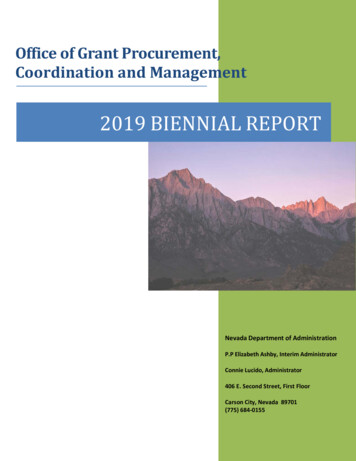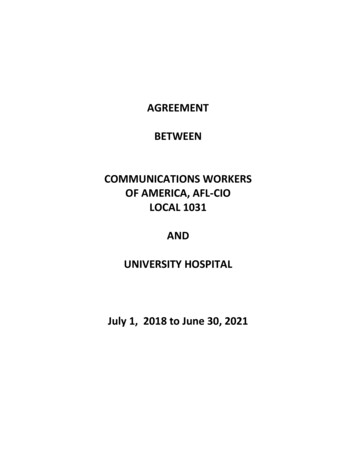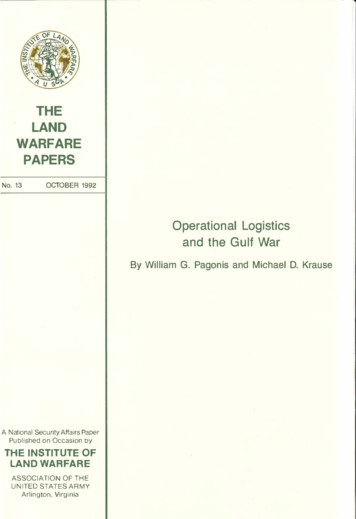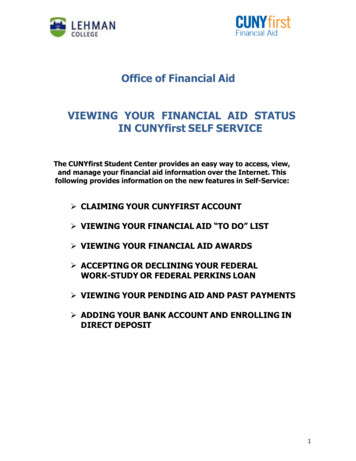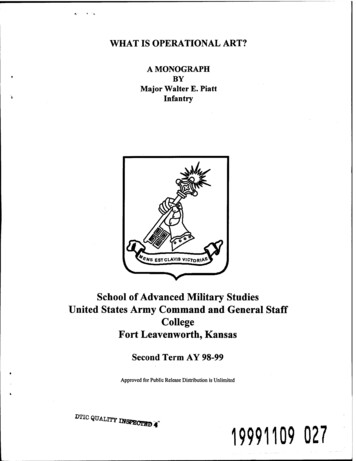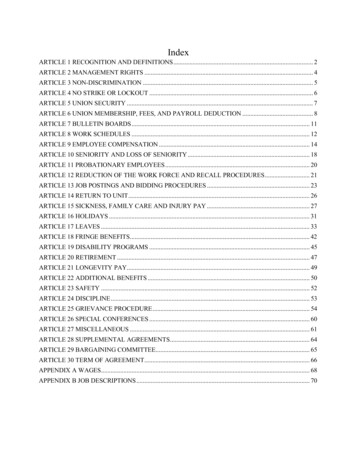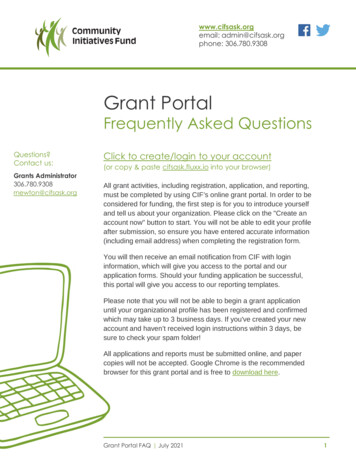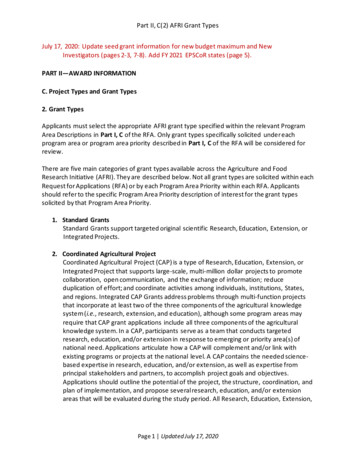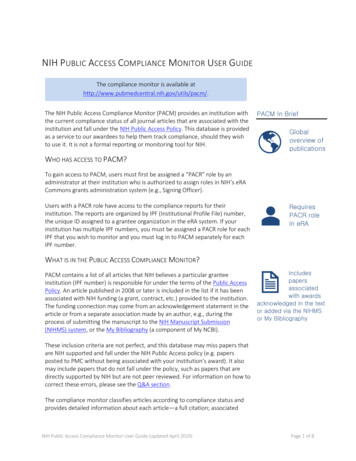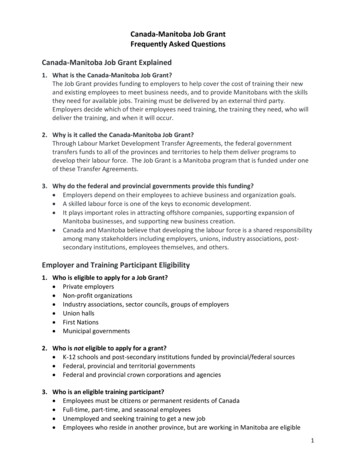
Transcription
Grant and Per Diem Operational CallJeff Quarles, MRC, LICDCNational Director, GPDChelsea Watson, MSPHDeputy Director, GPDTuesday, March 10, 2020 at 2pm Eastern/11am PacificVisuals: http://va-eerc-ees.adobeconnect.com/gpdbh/Audio: 1-800-767-1750 Code: 17663#
Agenda1. Grant and Per Diem (GPD) Announcements and Updates2. Office of Business Oversight (OBO) Announcements and Updates3. Working with Women Veterans in Grant and Per Diem Programs4. Next StepsVETERANS HEALTH ADMINISTRATION2
GPD Program Office Announcements and Updates:NOFAs1. Transition in Place (TIP) Notice of Funding Availability––––Published on February 18th and due by Wednesday, April 22nd at 4pm ETElectronic Submission via GIFTSOpen to new and existing applicantsResources on our website: https://www.va.gov/homeless/gpd.asp2. Special Needs Notice of Funding Availability– Due by April 27th at 4pm ET– Open existing 11 applicants only– Resources on our website: https://www.va.gov/homeless/gpd.aspVETERANS HEALTH ADMINISTRATION3
GPD Program Office Announcements and Updates: COVID-19 Overview– Safety of Veterans– Safety of Staff Proactive Preparation and Planning– Communication with local health department– Reviewing information including resources on GPD Provider website– Having a conversation with staff and then with Veterans Plan by using case scenario What would you do Option Tips– Handwashing, Limit touching of Face, Regular surface cleaning (Team effort)– Participate in future learning opportunitiesVETERANS HEALTH ADMINISTRATION4
Office of Business Oversight Upcoming Site Visits– Green Doors, Austin, TX – March 24-26– Matthew 25, Nashville, TN – April 7-9– Center for Veterans Issues, Milwaukee, WI – April 7-9 Upcoming Training – Unallowable Costs Training Item of the Month: Policies and Procedures– Policies and procedures are a set of written documents that describe an organization’s policies for operation – “what is tobe done” the procedures necessary to fulfill the policies – “how it is to be completed”– All staff must be familiar with these documents– Documents must be kept up-to-date– Documents must incorporate Federal and GPD grant regulations and provisionsVETERANS HEALTH ADMINISTRATION5
Lori S Katz, Ph.D.VA Puget Sound Health Care System
Introduction Sexual trauma is extremely common among women veteransin general, and especially in GPD programs Majority of cases happened in an on-going fashion and havelifelong consequences Before we can discuss treating women in GPD programs, it isimportant to understand who and what we are treating
Case Example: Julie Julie’s parents divorced when Julie was 2 years old. Her fatherleft and she never saw him again. When Julie was 10 her motherremarried. Her step-father had his son from a previous marriage. Julie knew how important it was for her mother to have thismarriage work and she was told repeatedly is was her job to “benice to her older step-brother” When Julie was 12, her step-brother would sneak into her roomat night and sexually abuse her.
Julie was afraid to tell her mother and instead told afriend at school. The next day Julie was asked to go to the Principal’soffice and was questioned about her step-brother. CPS was sent to her home and Julie was terrified shewould be taken away from her parents.
Her mother was furious and refused to look or speak toJulie for weeks. Julie lied about the abuse and the casewas dismissed. She thought it was better that way since her step-brotherwas going off to college soon and she wanted to keep thepeace in her family. Although, she never felt the sametowards her mother. She bought a pocket knife and slept with it in her bed. Herstep-brother never tried anything with her again. But shehad to continue to live with him and her parents acted likenothing happened.
Julie started having behavioral problems at school. She missedclasses, started smoking marijuana and drinking alcohol. She wassexually promiscuous, after all, if she was a sex object at least itwould be on her own terms. Julie felt alone, confused and ashamed. Why was this happening?“There must be something wrong with me,” she thought She wanted to drop out of high school. She was constantly arguingwith her parents. Everyone agreed that she should join themilitary– her parents wanted Julie to have structure and Juliewanted to escape.
When Julie turned 17, she joined the US Navy She was the happiest she had ever been in her life She was doing well in her job and had lots of friends. She felt likeshe belonged and could finally thrive. Then after a night of drinking and celebrating, one of her friendsoffered to drive her home. He sexually assaulted her.
Julie was numb– once again betrayed by her “brother” She felt alone, afraid, and blamed herself She was too afraid to report it and worried her command would beangry and blame her. Her job performance dramatically dropped. She had to continue tolive on base with her perpetrator who acted like nothing happened.She felt trapped. She thought about dying. Instead, she turned toalcohol. She developed migraines and got an early out of the military(medical discharge)
Fast forward 20 years She recently divorced her abusive husband because hestarted to beat their daughter when he got drunk. Her child was removed from the home. Julie couldn’t seem tokeep a job and increased her drinking to numb the pain. She stayed on people’s couches or hooked up with a man tohave a place for shelter. She had daily thoughts of suicide She had given up onherself, she was in despair.
Luckily, Julie is now living in a GPD program She is enrolled at the VA for substance abuse andPTSD treatment She is unemployed, has physical health issues, andmore than anything wants to regain custody of herdaughter
What happened? Julie is a survivor of sexual trauma. Can you name the event of trauma? Can you see similarities and patterns from her childhood that replicatedin the military? How would you prioritize her treatment plan? What might be barriers for treatment?
Homeless Women Veterans Women veterans are fastest growing part of homelesspopulation Rates have tripled from 2010-2015 and continues to grow Women veterans are three to four times more likely tobecome homeless than non-veteran womenGamache, Rosenheck, & Tessler, 2003; Project Muse, 2010
Why? Often a family, who might otherwise care for amember with problems is the original source ofabuse/violence With few resources, layers of trauma, difficultyreintegrating into civilian life Unemployment, emotional and physical healthproblems, relationship issues Could explain why women veterans have higherrisk for Homelessness
Regarding the research literature Women Veterans have a high prevalence of multiple events of trauma across theirlifespan starting in early childhood and continuing post-military with not only sexual trauma, but also a variety of abusive and unsupportive relationships(e.g., like Julie’s story)Kelly, Skelton, Patel, & Bradley, 2011
Characteristics of a sample of homeless womenveterans (N 33) Lifetime history of physical assault77%Lifetime history of rape80%MST53%Substance abuse32%Risk factors of homelessness among female Veterans: unemployed, disabled, having poor health, and PTSDCharacteristics: children or pets, couch surf, quick relationships, mayfeel lost in civilian world, veteran attitude of self-relianceWashington, 2010
Military Sexual Trauma (MST) Although rates are extremely high, MST is STILL often minimized, victimsfeel blamed, unsupported and ostracized (military motivated to deny) MST occurs in a context—that context is being in the military, where onehas to continue to work and live. Usually occurs by someone also in the military victim has to continue towork and live with the perpetrator, friends of the perpetrator, and/orcommand of the perpetrator*** FEAR: “Will this happen to me again? How will this affect my career? Whoknows about it?” BLAME: “I should have known better I should have screamed or foughtharder Why did this happen to me? This is my fault !” ANGER: “I trusted this person, I trusted the military There is no justice, Mycareer and life are ruined, I feel so betrayed.”
In depth interviews of militarysexual trauma: A study ofWomen VeteransKatz, Huffman, & Cojucar, 2016
Study “In her own words” 21 female veterans interviewed regarding 29 events of MST/assault Self-selected sample, all had completed therapyCommon themes revealed:67% of participants had multiple childhood (pre-military) trauma69% knew their perpetrator prior to the assault -- 60% were superiors (abuse of power)52% had to continue to interact with perpetrator as part of her job52% included violence (hitting, choking, forcing, threats)67% reported being seriously injured or pregnant as a result of assault; however, only28% received help. (See Zaleski & Katz, 2014)52% said MST lead to an early discharge from the military76% stated MST interfered with ability to have intimate relationships71% had suicidal ideation, 14% suicide attempts on active duty, 38% made asuicide attempt some time MST
MST Isolates the victimNo outlet for support/ most not reportedNo closure or retribution to perpetratorContinues to have consequencesBlamed, accused, not believedAlters cognitions, self-esteem, safety, attachment to othersFurther and further isolation “no one understands me”“I don’t belong” “I don’t matter .”
Why is this important? Disconnection from others Isolated from the unit/continuedabuse, Ruins careers– get out of military early Unable to trust or sustain a healthy relationship MST disrupts perceived Attachment difficulty connecting with others Also, disrupts internal sense of security Numbing Coping Strategies: Addictions, eating disorders, running Veterans with MST have increased risk of suicidal ideation, suicideattempts, and suicide completion (Monteith et al, 2016; Kimerling et al, 2016)
A word on Attachment: Harlow’smonkeysEven with food and water, we are biologically wired to craveand seek social interactions
Elements for secure attachmentFeel lovedenoughHave healthyBoundaries andlimitsSecure AttachmentFeel safeenoughHave healthy amountof self-direction, andfreedom to explorethe world
Sexual trauma and attachmentAttachment is robust – strongest predictor of success in living!But it CAN and does CHANGE over time in response to significantexperiencesWe are LEARNING BEINGS!Sexual trauma can disrupt secure attachment, or reinforce insecureattachment and set in motion long-term interpersonal patterns andperceptions about the self & others (holograms)We can reprocess the patterns and help people dislodge negative beliefsfrom the pastIf treatment can improve attachment, then this can have a tremendouspositive impact on people’s lives
Proposed Top 5 issues from MST1. Isolated- disconnected, misunderstood (ostracized)2. Fear of reoccurrence - Vulnerable (anxiety, nightmares)3. Lack of closure - Injustice, (resentment/anger)4. Self-blame “It’s my fault if only ” (as if this would have prevented the trauma)5. Difficulty in relationships (confusion about what is a healthy relationship? Distortedself-concept, poor self-esteem, boundaries, sexual issues- unable to engage, respond, orenjoy intimate touch
Proposed Top issues for womenveterans in GPD Self-esteem/self-worth (“you matter and you belong”)Reconnect with community (interpersonal functioning)Reconnect with a purpose, a futureAddress physical health issues including healthy livingAddress mental health issues including sexual traumaAddress family issues (divorce, custody, family discord)Address lack of income (school, employment, disability)Compared to men: more ST (fear of men/hyper sexual, identity as female withoutbeing sexualized, safety concerns, fear of trusting others), family issues as care-takers,mothers, daughters, wives
“Renew” &Warrior RenewWarrior Renew:VA Salt Lake City
Holistic approachIf ST is the underlying cause of Homelessness, then let’s treatthe ST before sending women out to get jobs/housing!2004 awarded VA Special Needs Grant:CollaborationVA: A 12-week tx program for women with sexual trauma (IOP)Community partner: provided GPD supportive housing forhomeless women veterans
Phases of treatmentAll classes follow a progression1. Safety and trustBuild sense of communityLearn new coping skills2. Deepen awarenessBecome aware of patternsReappraise meaning of trauma3. Redefine the self and futureCommit to healthier relationshipsPlan for the future
Content of ProgramCommunity building experiences Exploring space, sound, movement, imagination, power, trustTopic of the week (12 topics) Weekly themes incorporated in all classesSleep/NightmaresTriggers/AnxietyIdentifying relationship patternsAnger & resentmentsSelf- blame, shame and powerSexuality, boundaries, Communication skillsLosses, grief and gratitude Affect regulation skills Journaling assignmentsIOP met 5 days a week (integrated curriculum)Groups: Trauma, Feelings, Self-care, Relationships, & AddictionsAdjunctive activities: Art therapy, Yoga, Meditation, JournalingRecreational outings: kayaking, movies, baseball, art museum
Based on Holographic Reprocessingtherapy People are motivated to “make sense” of their experience and in sodoing construct a framework that explains their experience “Oh this is how the world is & this is who I am ” learned through experiences Past acts like a filter or lens inside Virtual Reality Goggles! Through which we anticipate, expect, interpret, andrespond to the worldIn this approach we target patterns not a specific eventhelloGoaway!
Experiential hologramsSee Katz, 2005 for details
Experiential holograms It’s called Experiential because it is formed by experience It’s called Hologram because it feels so real but is actually an illusion just because you have experienced (betrayal,neglect, being taken advantage of, criticized, abused etc) in the past, doesnot mean it has to continue to be that way. People (unconsciously) respond in ways that perpetuate and therefore,confirm their holograms.
Emotions “light up” memoriesWhen one aspect of an event occurs, the feelings andassociations of all past events also occurs. (explanation fortriggers)Light bulbs eventsString emotion
A cascade of re-enactments These interpersonal dynamics will undoubtedly play outamong residents in GPD program! (some will perceive:betrayal, criticism, rejection, neglect, endangerment--- andreact accordingly)
STUDY 1: 12 cohorts/112 started treatment, 97 graduated (13 % drop)12-week IOP (75% housed at GPD )
Positive factors
STUDY 2: Does Warrior Renew improveperceived attachment style ?70 started treatment/62 graduated (IOP) 89% had MST, of those, 85% had multiple events87% had childhood ST, of those 89% had multiple events79% had adult/domestic violence, of those 94% had multipleOnly one person had a single event of ST-- which was MSTAll completed the Relationship Scale Questionnaire (RSQ) (trait measure)pre and post Insecure-preoccupied*p .05, **p .01 ***p .001t(61) 2.17 *t(61) -4.20 ***t(61) -2.17 *t(61) .43
Study implications If participants perceive relating to others with less fear and less avoidance, andinternalize an increased sense of security, then they may be more likely to engage in activities and social interactions supporting an “upward spiral” approach to healing.
STUDY 3: Long-term outcome study41 enrolled, 37 completed treatment, 32 completed studyMeans across time
4.134.64Means across time5.00
Lessons Learned-- “5 C’s” Consistent boundaries/rules Be clear so folks know what to expect Compassion/caring (take a stand for their healing) Consistent Communication between staff! Seek Consultation and debriefing Stick to your Curriculum (Coherence) Have Calming skills at the ready (Cleansing breath, aroma therapy,grounding skills)
Other challenges Many women veterans have children and/or pets and most GPDprograms cannot accommodate Expect conflicts, splitting, socially immature behavior, lying,manipulating, relapsing, pushing boundaries, breaking rules “normal” for staff to be frustrated But see veteran’s behavior through their VR gogglesEvery upset is an opportunity for new learningSupport each other to stay grounded and see bigger pictureStay the course (centering clay)
Co-ed environments Unique challenges and potential healing opportunities for bothgenders to improve empathy Clear rules of engagement but also maybe offer a class or forumto discuss healthy relating Opportunity to teach Respect, Healthy boundaries, Focus onhealing– instead of getting distracted by sexual high/attention Address dress codes, disrespectful speech and actions,dominance, negative generalizations: “all men or allwomen ”
Thank you!Lori.Katz@va.gov
Wrap Up for Per Diem Only and TIP GranteesNational GPD Operational Grantee Call All Grantee Call-Tuesday, April 10th at 2pm Eastern/11am Pacific– Guest Presenter: S.A.V.E. Financial Management GPD Questions?– 1st : Review Grant Materials and Training– 2nd : Connect with your Supervisor– 3rd : Contact your GPD Liaison (Include FAIN)– 4th : Contact the GPD Program Office at gpdgrants@va.gov (Include FAIN)& Cc GPD LiaisonVETERANS HEALTH ADMINISTRATION56
Julie for weeks. Julie lied about the abuse and the case was dismissed. She thought it was better that way since her step-brother was going off to college soon and she wanted to keep the peace in her family. Although, she never felt the same towards her mother. She bought a pocket knife and slept with it in her bed. Her
